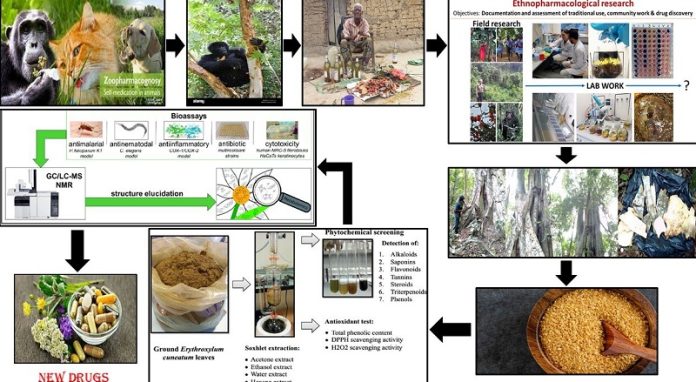
A recent study has revealed that four plants consumed by wild gorillas in Gabon also have medicinal properties and are used by local communities in traditional medicine.
These plants show antibacterial and antioxidant properties, offering clues for new drug discovery.
The research, led by Leresche Even Doneilly Oyaba Yinda from the Interdisciplinary Medical Research Center of Franceville in Gabon, was published in PLOS ONE.
Wild gorillas, like other great apes, often eat plants that can help them with various health issues. Interestingly, many of these plants are also used by local people for similar purposes in traditional medicine.
To explore this connection, researchers observed the behavior of western lowland gorillas in Moukalaba-Doudou National Park, Gabon, and noted the plants they ate.
They also interviewed 27 residents of a nearby village, including traditional healers and herbalists, to learn which plants were used in local medicine.
The team identified four key plant species that are both consumed by gorillas and used in traditional healing practices: the fromager tree (Ceiba pentandra), giant yellow mulberry (Myrianthus arboreus), African teak (Milicia excelsa), and fig trees (Ficus species).
The researchers then tested samples of bark from these plants to investigate their medicinal potential.
The results were promising. The bark from all four plants showed antibacterial activity against at least one multidrug-resistant strain of Escherichia coli (E.coli), a bacterium that can cause serious infections.
In particular, the fromager tree demonstrated strong antibacterial activity against all tested E.coli strains.
Additionally, the bark of these plants contained compounds with known medicinal effects, such as phenols, alkaloids, flavonoids, and proanthocyanidins, which are all known for their health benefits.
Although it is unclear if the gorillas consume these plants specifically for their medicinal properties, the study suggests that the plants could hold great potential for new drug discoveries, especially for treating infections caused by bacteria resistant to existing antibiotics.
Central Africa is a highly biodiverse region, home to many unexplored plants that could have medicinal properties. This research highlights how studying both wildlife behavior and traditional knowledge can provide important clues for modern medicine. The plants identified in this study may be valuable targets for future research in the fight against multidrug-resistant bacteria.
The authors of the study note that alternative medicines and therapies could play a crucial role in addressing current and future public health challenges.
They emphasize the potential of “zoopharmacognosy,” the study of how animals use plants to self-medicate, as a promising approach for discovering new drugs that could benefit humans.



